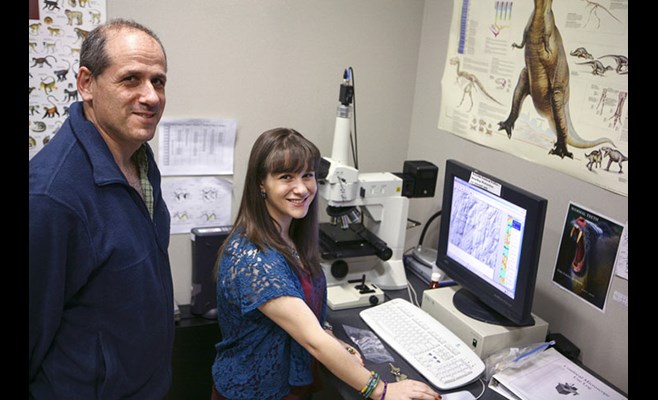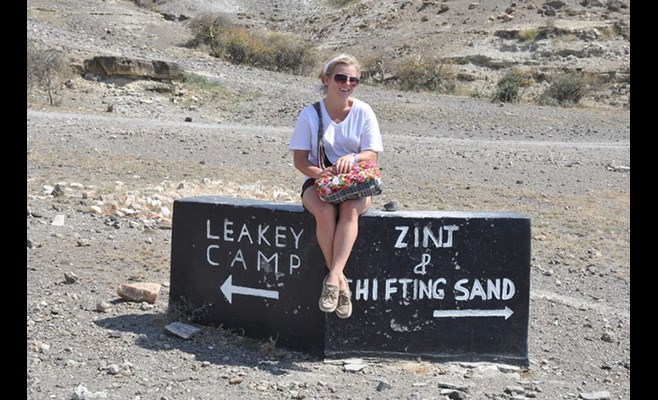New Studies Explore Impact of Environmental Change on Tooth Wear
FAYETTEVILLE, Ark. — Researchers at the University of Arkansas have established that pits and scratches on the teeth of mammal fossils give important clues to the diet of creatures that lived millions of years ago. Two new studies, both involving undergraduate Honors College students, analyze the effect of environmental change on the teeth of existing species, and may shed light on the evolutionary fossil record.
Peter Ungar, Distinguished Professor and chair of the anthropology department, mentored the students and is a coauthor on both papers.
Both studies compare dental wear of species in environments that are relatively undisturbed to those in environments that have been disturbed by human development.
“Human disturbance, from an ecological perspective, is not a great thing, but for folks like me, they’re really cool natural experiments,” Peter Ungar said. “If we can understand the reaction of living animals, including primates, to environmental change, then we can apply that to the past, to understand evolution. Conversely, we can use our understanding of how things change on evolutionary time scales to get a better appreciation for our effects on the environment today.”
Tracking Lemurs in Madagascar
The paper “Mechanical food properties and dental topography differentiate three populations of Lemur catta in southwest Madagascar” was recently accepted by the Journal of Human Evolution, the premier journal in the field.
Emily Fitzgerald (B.A. in anthropology, magna cum laude, ’12) and Andrea Riemenschneider (B.A. in anthropology, cum laude, ’13), who were undergraduate honors students at the time, used data collected in Madagascar by Frank Cuozzo and Michelle Sauther. Since 2003 Cuozzo and Sauther have caught and made molds of the teeth of ring-tailed lemurs across a variety of habitats.
Building on research by first author Nayuta Yamashita, Fitzgerald and Riemenschneider made high-resolution casts of the molds, then used a laser scanner to make 3-D models of the teeth, which they analyzed using global-information system software. Their findings confirmed different patterns of wear in different settings.
Lemurs in disturbed areas were most heavily impacted, wearing their teeth “down to nubbins – we’re not entirely sure why,” Ungar said. This finding could help scientists interpret wear-related tooth shape changes more generally.
ComparinG Capuchin and Howler Monkeys in the Brazilian Amazon
In “Environmental Perturbations Can be Detected Through Microwear Texture Analysis in Two Platyrrhine Species From Brazilian Amazonia,” recently published in the American Journal of Primatology, Almudena Estalrrich, a doctoral exchange student from Spain, and Mariel Williams Young (B.A. in anthropology and Spanish, magna cum laude, with a minor in psychology, ’13), then an undergraduate Honors College student, analyzed the effects of habitat variation on capuchin and howler monkeys.
Each species was sampled from environments ranging from minimally disturbed to an area that had been deforested with the construction of a hydroelectric dam.
Young used a confocal microscope to zoom in on a very small part of the tooth – the wear area where the upper and lower teeth come into contact. The team predicted that capuchins, which eat nuts and berries, would be more impacted by environmental disturbance than howler monkeys, which eat leaves.
Their findings confirmed this prediction, and established that dental microwear texture analysis is an effective tool to detect subtle differences in diets among living primates. Studies like this one, which use well-documented specimens with differences in habitats, suggest that subtle changes in microwear may shed light on habitat-forced diet changes in the fossil record.
Peter Ungar has worked with dozens of Honors College students in the past 20 years, and several have published their undergraduate research in peer-reviewed journals.
“Honors students are bread and butter for me,” Ungar said. “I couldn’t get done what I get done, research-wise, without their help.”
“It feels great to have a publication early in my career,” said Mariel Young, who completed a master’s degree in human evolutionary studies at Cambridge and is now pursuing a doctoral degree in human evolutionary biology at Harvard. Young was awarded the Gates Cambridge Scholarship and NSF Graduate Fellowship, and credits her success to research with Ungar: “These two awards have had a huge impact on my career, and my initial research at U of A in Dr. Ungar's lab is definitely what set me on the path toward achieving them.”
“We’re very proud of these three alumni, and pleased that, yet again, undergraduate thesis research conducted by our Honors College students has been published in top journals,” said Lynda Coon, dean of the Honors College.
About the Honors College: The University of Arkansas Honors College was established in 2002 and unites the university’s top undergraduate students and professors in a learning environment characterized by discovery, creativity and service. Each year the Honors College awards up to 90 freshman fellowships that provide $70,000 over four years, and more than $1 million in undergraduate research and study abroad grants. The Honors College is nationally recognized for the high caliber of students it admits and graduates. Honors students enjoy small, in-depth classes, and programs are offered in all disciplines, tailored to students’ academic interests, with interdisciplinary collaborations encouraged. One hundred percent of Honors College graduates have engaged in mentored research.
About the University of Arkansas: The University of Arkansas provides an internationally competitive education for undergraduate and graduate students in more than 200 academic programs. The university contributes new knowledge, economic development, basic and applied research, and creative activity while also providing service to academic and professional disciplines. The Carnegie Foundation classifies the University of Arkansas among only 2 percent of universities in America that have the highest level of research activity. U.S. News & World Report ranks the University of Arkansas among its top American public research universities. Founded in 1871, the University of Arkansas comprises 10 colleges and schools and maintains a low student-to-faculty ratio that promotes personal attention and close mentoring.
Topics
Contacts
Peter Ungar, distinguished professor and chair, anthropology department
J. William Fulbright College of Arts and Sciences
479-575-6361,
pungar@uark.edu
Kendall Curlee, director of communications
Honors College
479-575-2024,
kcurlee@uark.edu
Headlines
U of A Bands to Hold Three Nights of Concerts
The Symphonic Band, the Wind Symphony, the 4 O'Clock and 5 O'Clock Bands and the Wind Ensemble will perform April 21-23 at the Faulkner Performing Arts Center on the U of A campus.
Honors College to Host 'Best in Show' Dog Celebration
The campus and community are invited to celebrate our furry friends with popsicles, water and dog treats from 3-4 p.m. Thursday, April 25, in the Gearhart Courtyard.
New Parasite Affecting Canadian Partridges Named for Arkansas Poultry Scientist
A long-time colleague in Canada gave a newly found parasite the scientific name Eimeria hargisi in honor of U of A poultry science researcher Billy Hargis.
U of A School of Law Student Selected for Ms. J.D. Leadership Academy Intensive
Tristan Branstetter-Thomas, a second-year law student, was one of 30 students from across the country chosen to participate in the leadership academy at the Northwestern Pritzker School of Law in Chicago.
Needy Honored as Distinguished Alumna of University of Pittsburgh Engineering College
College of Engineering Dean Kim Needy was among seven alumni of the University of Pittsburgh Swanson School of Engineering honored in April as part of the 2024 Class of Distinguished Alumni.








